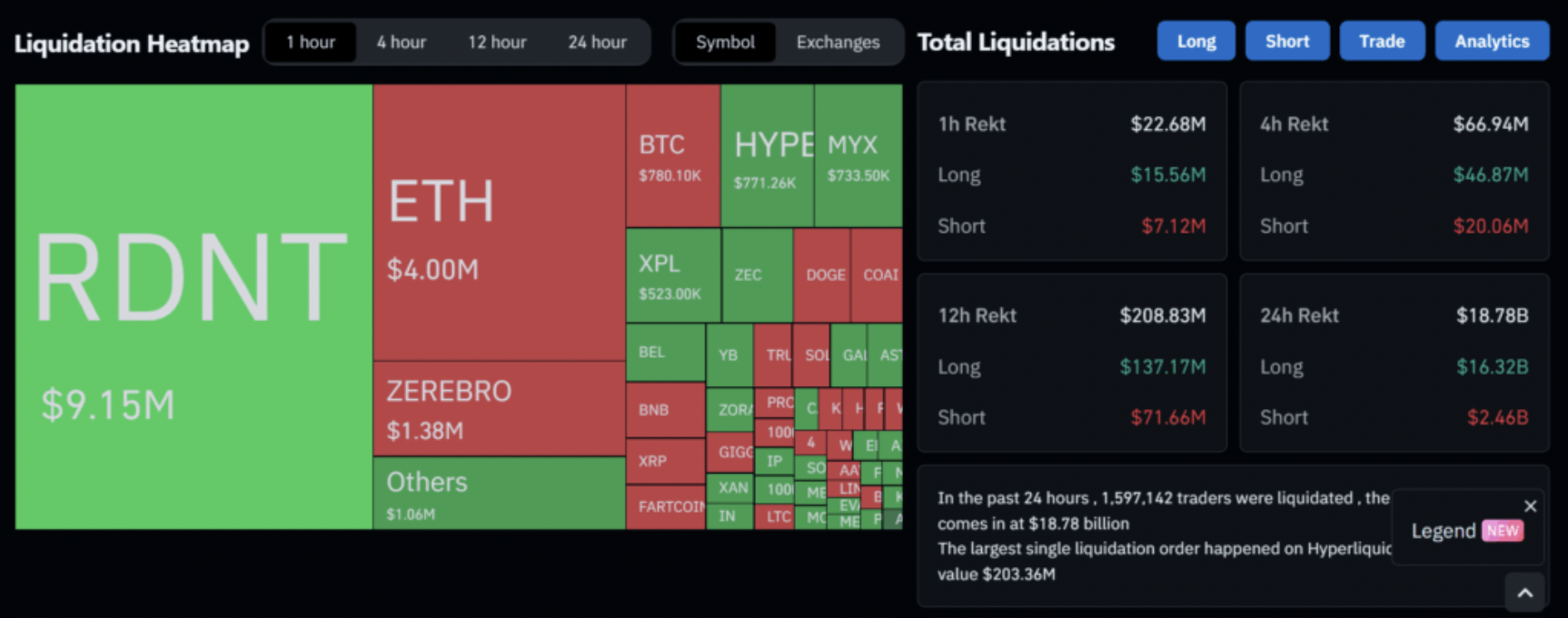When Markets Outrun Machines: The October 10th Lesson in Crypto Infrastructure



One bad news event and the entire crypto market tumbled. Why?
The October 10th crypto crash will be remembered not only for the billions liquidated, but for what it revealed about the state of our infrastructure. This wasn’t just a test of trading strategies or risk management. It was a stress test of the systems that power our markets.
We need to acknowledge scale.
In minutes, established assets - not speculative tokens, but blue chips, collapsed beyond comprehension:
These weren’t unknown microcaps. These were assets traded on the largest exchanges in the world.
In the middle of cascading liquidations, major trading platforms began to show signs of strain. API responses slowed. Price feeds lagged. Spreads grew. Traders reported frozen screens while liquidation engines continued operating in the background.

It’s easy to talk about billions in liquidations as if they’re just numbers on a chart. But behind those numbers are individuals who lost everything - people who had conviction, who didn’t expect data delivery to break at the worst possible moment.
For some, it wasn’t just capital that vanished, but confidence - in markets, in platforms, in the idea that they ever had a fair chance. Markets are meant to test conviction, not connectivity.
Since we’re all taking about how exchanges functioned during yesterday’s nuke, let me tell you how I got liquidated on Binance.
— CoinMamba (@coinmamba) October 11, 2025
I was running a pair trade, one long and one short position. As the prices started nuking, my margin got low and instead of partially liquidating my…
Some have framed this crash as the result of a political shock. A tariff announcement. A macro headline. But that only explains the first move - not the cascade that followed.
As one observer put it:
“This wasn’t just risk-off behavior. This was structural breakdown. $6B liquidated in the first hour. That’s not a selloff. That’s a feedback loop.”
One of the most revealing failures came from wrapped assets like wBETH. In theory, these tokens represent staked ETH, like a claim check. But as infrastructure buckled: wBETH crashed from ~ $3,800 parity to $430
Not because ETH lost value, but because spot markets went illiquid.
Margin systems marked collateral down based on panicked spot trades, not underlying reality
The result?
Solvent traders were liquidated as if they held worthless collateral. Liquidation engines continued operating - but the data they relied on no longer reflected truth.
The same occurred with USDe, a synthetic dollar fully redeemable at par throughout the crisis. Yet exchanges marked it at $0.65 based on thin spot markets. Protocol was solvent. Traders were not.
The Oct 11 Crypto Crash — What Really Happened
— ElonTrades (@ElonTrades) October 12, 2025
TL;DR:
Roughly $60–90M of $USDe was dumped on Binance, along with $wBETH and $BNSOL, exploiting a pricing flaw that valued collateral using Binance’s own order-book data instead of external oracles.
That localized depeg triggered…
Some asked, “Why didn’t market makers step in?” The answer is - they couldn’t.
When the largest venues freeze or throttle API access, liquidity providers disengage. They can’t hedge. They can’t verify prices. Providing bids becomes reckless. The result was a “liquidity vacuum” - the very actors who stabilize order books were structurally unable to intervene.
Crypto markets now move faster than ever. Liquidation engines run in milliseconds, but infrastructure still depends on rate-limited APIs, congestion-prone endpoints, and centralized data chokepoints. During the crash, platforms throttled APIs - traders were left unable to adjust positions or close trades.
This is the gap we must acknowledge: Our systems are built for normal days. Crashes are anything but normal.
Amid the chaos, decentralized exchanges and on-chain protocols absorbed record volume. No downtime. No halts. Transactions cleared. DeFi was far from perfect, but it honored one core promise: if the market moves, you see it move. There were no hidden throttles.
In less than 48 hours, @aave has generated $3.5M+ in revenue.
— jfab.eth (@josefabregab) October 11, 2025
Flawless performance during a black swan event, and clear sustainability regardless of market conditions. pic.twitter.com/EfSwQmV2uD
It’s easy to dismiss this crash as a one-off event. It isn’t. The next cycle will feature more algorithmic trading, faster liquidation engines, and deeper leverage - not less. Yet much of our infrastructure still operates on legacy assumptions.
We cannot tell users to “trade responsibly” if we don’t build systems that operate reliably. Market risk is accepted. Technical risk is not.
Every exchange, builder, and infrastructure provider now faces the same question: can your systems survive the next crash without compounding the damage?
This isn’t about pointing fingers. Markets will always be unpredictable. Outages happen. But user trust is earned through preparation. Fail-safes. Redundant data gateways.
If we want a financial system that can compete with the old one, we need to hold ourselves to higher standards. Not only in uptime and speed, but in operational integrity. Real-time data cannot freeze when it matters most. The next cycle move will come with another stress test. Whether we pass or fail won’t depend on prices. It will depend on the infrastructure we build today.
Reflections based on market observations, exchange communications, and public data. These views are independent opinions of Tatum employees, not on behalf of any entity.
Build blockchain apps faster with a unified framework for 60+ blockchain protocols.